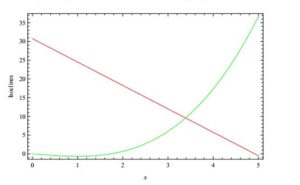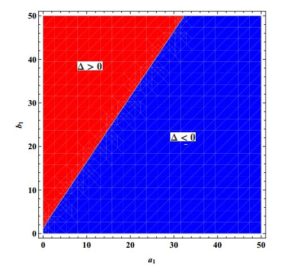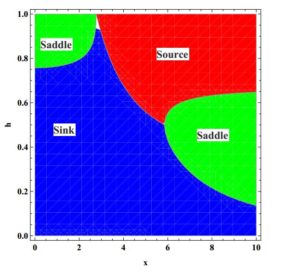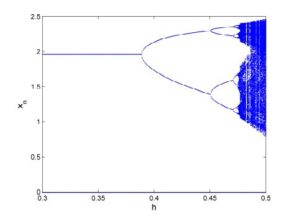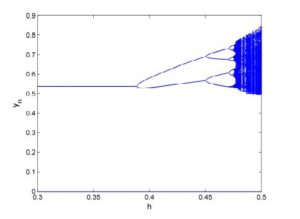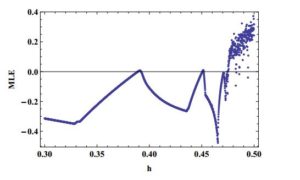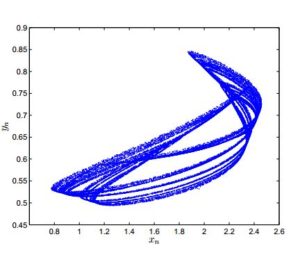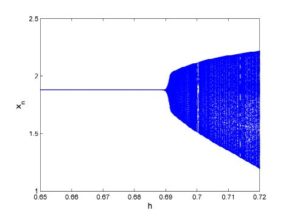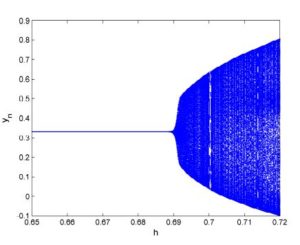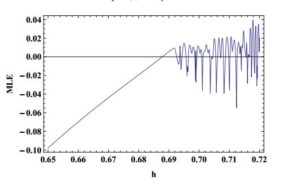Open Journal of Mathematical Sciences
ISSN: 2523-0212 (Online) 2616-4906 (Print)
DOI: 0.30538/oms2018.0029
Flip and Hopf Bifurcations of Discrete-Time Fitzhugh-Nagumo Model
Qamar Din\(^{1}\), Sadaf Khaliq
Department of Mathematics, The University of Poonch Rawalakot, Pakistan. (Q.D & S.K)
\(^{1}\)Corresponding Author: qamar.sms@gmail.com
Abstract
Keywords:
1. Introduction
In 1961 FitzHugh and Nagumo [1] presented the following two-dimensional model:2. Existence of equilibria and stability
The steady-states of (2) satisfy the following system of algebraic equations:- If \(\Delta > 0\), then system (2) has three distinct equilibrium points.
- If \(\Delta = 0\), then system (2) has a multiple equilibrium points.
- If \(\Delta < 0\), then system (2) has a unique positive equilibrium point.
Figure 1. For \(a_1=4.92\) and \(b_1=0.16\) existence of unique positive equilibrium for (2).
Figure 2. Regions for existence of various equilibria.
- \(\Delta< 0\) if and only if \(0< b_1\le1\), or \(b_1>1\) and \(a_1>\frac{2}{3} \sqrt{\frac{-1+3 b_1-3b_1^2+b_1^3}{b_1}}\).
- \(\Delta>0\) if and only if \(b_1>1\) and \(a_1< \frac{2}{3} \sqrt{\frac{-1+3 b_1-3b_1^2+b_1^3}{b_1}}\).
- \(\Delta=0\) if and only if \(b_1>1\) and \(a_1=\frac{2}{3} \sqrt{\frac{-1+3 b_1-3b_1^2+b_1^3}{b_1}}\).
Theorem 2.1. [16] Assume that \(\Delta< 0\), then unique positive equilibrium \((x,y)\) has the following topological classification: (i) \((x,y)\) is a sink if and only if $$ \left|2-\frac{b_1 h}{c_1}+c_1 h \left(1-x^2\right)\right|< 2+h \left(c_1+h-c_1 x^2\right)- \frac{b_1 h \left(1+c_1 h \left(1-x^2\right)\right)}{c_1}< 2. $$ (ii) \((x,y)\) is a saddle if and only if $$ \left(2-\frac{b_1 h}{c_1}+c_1 h \left(1-x^2\right)\right)^2-4\left(1+h \left(c_1+h-c_1 x^2\right)- \frac{b_1 h \left(1+c_1 h \left(1-x^2\right)\right)}{c_1}\right)>0, $$ and $$ \left|2-\frac{b_1 h}{c_1}+c_1 h \left(1-x^2\right)\right|>\left|2+h \left(c_1+h-c_1 x^2\right)- \frac{b_1 h \left(1+c_1 h \left(1-x^2\right)\right)}{c_1}\right|. $$ (iii) \((x,y)\) is a source if and only if $$ \left|1+h \left(c_1+h-c_1 x^2\right)- \frac{b_1 h \left(1+c_1 h \left(1-x^2\right)\right)}{c_1}\right|>1, $$ and $$ \left|2-\frac{b_1 h}{c_1}+c_1 h \left(1-x^2\right)\right|< \left|2+h \left(c_1+h-c_1 x^2\right)- \frac{b_1 h \left(1+c_1 h \left(1-x^2\right)\right)}{c_1}\right|. $$ (iv) \((x,y)\) is non-hyperbolic if and only if $$ \left|2-\frac{b_1 h}{c_1}+c_1 h \left(1-x^2\right)\right|=\left|2+h \left(c_1+h-c_1 x^2\right)- \frac{b_1 h \left(1+c_1 h \left(1-x^2\right)\right)}{c_1}\right|, $$ or $$ \left(c_1+h-c_1 x^2\right)- \frac{b_1 \left(1+c_1 h \left(1-x^2\right)\right)}{c_1}=0 $$ and $$ \left|2-\frac{b_1 h}{c_1}+c_1 h \left(1-x^2\right)\right|\le2. $$
If we choose \(b_1=0.45\), \(c_1=0.15\), \(h\in[0,1]\) and \(x\in[0,10]\), then topological classification for unique positive point of system (2) is shown in Figure 3.Figure 3. Topological classification for positive equilibrium.
3. Bifurcation analysis
Studying bifurcation analysis for discrete-time models is a topic of great interest. Recently, there are many articles have published for the investigation for period-doubling and Neimark-Sacker bifurcations in discrete-time models [17, 18, 19, 20, 21, 22, 23]. In this section, we explore the parametric conditions under which system (2) undergoes period-doubling and Neimark-Sacker bifurcations at its unique positive equilibrium point. For this, first we discuss the emergence of period-doubling bifurcation at positive equilibrium of system (2). Assume that \(P(-1)=0\), where \(P(\lambda)\) is defined in (5), then system (2) undergoes period-doubling bifurcation as \(h\) varies in a small neighborhood of \(h_0\) defined by $$ h_0:=\frac{b_1+\left(-1+x^2\right) c_1^2-\sqrt{-4 c_1^2+\left(b_1-\left(-1+x^2\right) c_1^2\right){}^2}}{\left(1+\left(-1+x^2\right) b_1\right) c_1}, $$ or $$ h_0:=\frac{b_1+\left(-1+x^2\right) c_1^2+\sqrt{-4 c_1^2+\left(b_1-\left(-1+x^2\right) c_1^2\right){}^2}}{\left(1+\left(-1+x^2\right) b_1\right) c_1}. $$ Secondly, we assume that $$ \left(b_1+\left(-1+x^2\right) c_1^2\right){}^2 \left(-4 c_1^2+\left(b_1-\left(-1+x^2\right) c_1^2\right){}^2\right)< 0. $$ Then system (2) undergoes Neimark-Sacker bifurcation as parameter \(h\) varies in a small neighborhood of \(h_1\) defined by: $$ h_1:=\frac{b_1+\left(-1+x^2\right) c_1^2}{\left(1+\left(-1+x^2\right) b_1\right) c_1}. $$ In order to verify aforementioned mathematical investigation for existence of period-doubling and Neimark-Sacker bifurcations, we choose particular parametric values for system (2) as follows:- [Period-doubling bifurcation] Let \(a_1=2.6\), \(b_1=1.2\), \(c_1=1.9\) and \(h\in[0.3,0.5]\). In this case, system (2) undergoes period-doubling bifurcation as \(h\) varies in a small neighborhood of \(h_0=0.39\). Moreover, the bifurcation diagrams for period-doubling bifurcation are shown in Figure 4 and Figure 5. Moreover, maximum Lyapunov exponents (MLE) are shown in Figure 6 and a chaotic attractor is depicted in Figure 7.
- [Neimark-Sacker bifurcation] Taking \(a_1=2.7\), \(b_1=2.5\), \(c_1=0.95\) and \(h\in[0.65,0.72]\). Then system (2) undergoes Neimark-Sacker bifurcation as \(h\) varies in a small neighborhood of \(h_1=0.69\). The diagrams for Neimark-Sacker bifurcation are given in Figure 8 and Figure 9. Furthermore, MLE are shown in Figure 10 and phase portrait at \(h=0.69\) is depicted in Figure 11.
Figure 4. Bifurcation diagram for \(x_n\).
Figure 5. Bifurcation diagram for \(y_n\).
Figure 6. Maximum Lyapunov exponents.
Figure 7. A chaotic attractor at \(h=0.5\).
Figure 8. Bifurcation diagram for \(x_n\).
Figure 9. Bifurcation diagram for \(y_n\).
Figure 10. Maximum Lyapunov exponents.
Figure 11. Phase portrait at \(h=0.69\).
4. Conclusion
The qualitative behavior for a two-dimensional discrete-time Fitzhugh-Nagumo model is investigated. Euler's forward scheme is implemented to obtain the discrete counterpart of the continuous Fitzhugh-Nagumo model. It is investigated that discrete-time model has rich dynamical behavior as compare to its continuous counterpart. The topological classification for steady-state solutions is discussed. Furthermore, parametric conditions for the existence of period-doubling bifurcation and Neimark-Sacker bifurcation are analyzed by taking \(h\( as bifurcation parameter. At the end numerical simulations are provided to illustrate the theoretical discussion.Competing Interests
The author(s) do not have any competing interests in the manuscript.References
- FitzHugh, R. (1961). Impulses and physiological state in theoretical models of nerve membrane. Biophysical Journal, 1(6), 445-467. [Google Scholor]
- Hodgkin, A. L., & Huxley, A. F. (1952). A quantitive description of membrane current and its application to conduction and excitation in nerve. The Journal of Physiology, 117(4), 500-544.[Google Scholor]
- Hindmarsh, J. L., & Rose, R. M. (1984). A model of neuronal bursting using three coupled first order differential equations. Biological Sciences, Proceedings of the Royal Society of London B, 221(1222), 87-102. [Google Scholor]
- Buzzi, C., Llibre, J., & Medrado, J. (2015). Hopf and zero-Hopf bifurcations in the Hindmarsh-Rose system. Nonlinear Dynamics, 83(3), 1549-1556. [Google Scholor]
- Chay, T. R., & Keizer, J. (1985). Theory of the effect of extracellular potassium on oscillations in the pancreatic beta cell. Biophysical Journal, 48(5), 815-827. [Google Scholor]
- Chay, T. R., & Rinzel, J. (1985). Bursting, beating and chaos in an excitable membrane model. Biophysical Journal, 47(3) 357-366. [Google Scholor]
- Chay, T. R. (1985). Chaos in a three-variable model of an excitable cell. Physical Dynamics, 16(2), 233-242.[Google Scholor]
- Chay, T. R. (1985). Glucose response to bursting-spiking pancreatic beta-cells by a barrier kinetic model. Biological Cybernetics, 52(5), 339-349. [Google Scholor]
- Chen, S. S., Cheng, C. Y., & Rulin, Y. (2013). Application of a two-dimensional Hindmarsh-Rose type model for bifurcation analysis. International Journal of Bifurcation and Chaos, 23(3), 1350055. [Google Scholor]
- Innocenti, G., Morelli, A., Genesio, R., & Torcini, A. (2007). Dynamical phases of the Hindmarsh-Rose neuronal model: Studies of the transition from bursting to spiking chaos. Chaos, 17(4), 043128. [Google Scholor]
- Jing, Z. J., Chang, Y., & Guo, B. L. (2004). Bifurcation and chaos in discrete FitzHugh--Nagumo system. Chaos, Solitons and Fractals, 21(3), 701-720. [Google Scholor]
- Liu, X. L., & Liu, S. Q. (2012). Codimension-two bifurcation analysis in two dimensional Hindmarsh-Rose model. Nonlinear Dynamics, 67(1), 847-857. [Google Scholor]
- Lange, E., & Hasler, M. (2008). Predicting single spikes and spike patterns with the Hindmarsh-Rose model. Biological Cybernetics, 99: 349. [Google Scholor]
- Li, B., & He, Z. (2014). Bifurcation and chaos in a two-dimensional discrete Hindmarsh-Rose model. Nonlinear Dynamics, 76(1), 697-715. [Google Scholor]
- Rocsoreanu, C., Georgescu, A., & Giurgiteanu, N. (2000). FitzHugh-Nagumo model: Bifurcation and Dynamics. Springer, Dordrechts. ISBN 978-94-015-9548-3 [Google Scholor]
- Kulenovi\'{c}, M. R. S., & Ladas, G. (2002). Dynamics of Second Order Rational Difference Equations: With Open Problems and Conjectures. Chapman and Hall/CRC, New York. ISBN 9781584882756 [Google Scholor]
- Din, Q. (2018). A novel chaos control strategy for discrete-time Brusselator models. Journal of Mathematical Chemistry. [Google Scholor]
- Din, Q., & Hussain, M. (2018). Controlling chaos and Neimark-Sacker bifurcation in a host-parasitoid model. Asian Journal of Control. [Google Scholor]
- Din, Q., Elsadany, A. A., & Ibrahim, S. (2018). Bifurcation analysis and chaos control in a second-order rational difference equation. International Journal of Nonlinear Sciences and Numerical Simulation, 19(1), 53--68. [Google Scholor]
- Din, Q. (2018). Bifurcation analysis and chaos control in discrete-time glycolysis models. Journal of Mathematical Chemistry. 56(3): 904--931.[Google Scholor]
- Din, Q., Donchev, T., & Kolev, D. (2018). Stability, Bifurcation Analysis and Chaos Control in Chlorine Dioxide-Iodine-Malonic Acid Reaction. MATCH-Communications in Mathematical and in Computer Chemistry, 79(3), 577--606. [Google Scholor]
- Din, Q. (2018). Controlling chaos in a discrete-time prey-predator model with Allee effects. International Journal of Dynamics and Control, 6(2), 858-872. [Google Scholor]
- Din, Q. (2018). Qualitative analysis and chaos control in a density-dependent host-parasitoid system. International Journal of Dynamics and Control, 6(2), 778--798. [Google Scholor]

